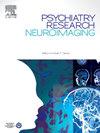Does hyperventilation alter the prefrontal hemodynamics of panic disorder during cognitive task? A functional near-infrared spectroscopy (fNIRS) based study
IF 2.1
4区 医学
Q3 CLINICAL NEUROLOGY
引用次数: 0
Abstract
Background
Cerebral hypofrontality has been implicated in the pathophysiology of panic disorder, (PD). This study examined the effect of symptom provocation on prefrontal cortex activity during a cognitive task in PD patients and healthy controls (HC) using functional near-infrared spectroscopy (fNIRS).
Methods
We included 20 drug-naïve PD patients and 20 HC. Participants performed the N-back task before and after hyperventilation, while prefrontal activation was recorded using fNIRS. Two-way repeated-measures ANOVA was used to analyze changes in task performance and brain activation.
Results
There was a significant group effect for two-back D′, F(1, 32) = 4.93, p = 0.03, η² = 0.13, indicating that PD participants performed worse than HC. A significant time × group interaction was observed during the zero-back task in LBA8 and right prefrontal regions: RBA10, RBA8, and RBA46 (all p < 0.05), suggesting that the HC group showed greater activation changes after hyperventilation.
Conclusion
Our findings highlight working memory deficits and prefrontal hypofunction in PD. The absence of right prefrontal deactivation after hyperventilation in the PD group, compared to HC, suggests altered right-hemisphere involvement in PD pathophysiology.
过度换气是否会改变认知任务中惊恐障碍的前额叶血流动力学?基于功能近红外光谱(fNIRS)的研究
背景:大脑额下功能低下与惊恐障碍(PD)的病理生理有关。本研究利用功能近红外光谱(fNIRS)研究了PD患者和健康对照(HC)认知任务中症状激发对前额叶皮层活动的影响。方法选取drug-naïve PD患者20例,HC患者20例。参与者在过度通气前后分别执行N-back任务,同时使用近红外光谱记录前额叶的激活情况。采用双向重复测量方差分析来分析任务表现和大脑激活的变化。结果双背D′存在显著的组效应,F(1,32) = 4.93, p = 0.03, η²= 0.13,说明PD参与者的表现较HC参与者差。在零背任务期间,在LBA8和右前额叶区域:RBA10、RBA8和RBA46中观察到显著的时间组相互作用(p <;0.05),提示HC组在过度通气后表现出更大的激活变化。结论PD患者存在工作记忆缺陷和前额叶功能障碍。与HC相比,PD组过度通气后右侧前额叶无失活,表明PD病理生理中右半球参与改变。
本文章由计算机程序翻译,如有差异,请以英文原文为准。
求助全文
约1分钟内获得全文
求助全文
来源期刊
CiteScore
3.80
自引率
0.00%
发文量
86
审稿时长
22.5 weeks
期刊介绍:
The Neuroimaging section of Psychiatry Research publishes manuscripts on positron emission tomography, magnetic resonance imaging, computerized electroencephalographic topography, regional cerebral blood flow, computed tomography, magnetoencephalography, autoradiography, post-mortem regional analyses, and other imaging techniques. Reports concerning results in psychiatric disorders, dementias, and the effects of behaviorial tasks and pharmacological treatments are featured. We also invite manuscripts on the methods of obtaining images and computer processing of the images themselves. Selected case reports are also published.

 求助内容:
求助内容: 应助结果提醒方式:
应助结果提醒方式:


